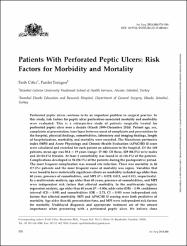| dc.description.abstract | Perforated peptic ulcers continue to be an important problem in surgical practice. In
this study, risk factors for peptic ulcer perforation-associated mortality and morbidity
were evaluated. This is a retrospective study of patients surgically treated for
perforated peptic ulcer over a decade (March 1999–December 2014). Patient age, sex,
complaints at presentation, time lapse between onset of complaints and presentation to
the hospital, physical findings, comorbidities, laboratory and imaging findings, length
of hospitalization, morbidity, and mortality were recorded. The Mannheim peritonitis
index (MPI) and Acute Physiology and Chronic Health Evaluation (APACHE) II score
were calculated and recorded for each patient on admission to the hospital. Of the 149
patients, mean age was 50.6 6 19 years (range: 17–86). Of these, 129 (86.5%) were males
and 20 (13.4%) females. At least 1 comorbidity was found in 42 (28.1%) of the patients.
Complications developed in 36 (24.1%) of the patients during the postoperative period.
The most frequent complication was wound site infection. There was mortality in 26
(17.4%) patients and the most frequent cause of mortality was sepsis. Variables that
were found to have statistically significant effects on morbidity included age older than
60 years, presence of comorbidities, and MPI (P ¼ 0.029, 0.013, and 0.013, respectively).
In a multivariate analysis, age older than 60 years, presence of comorbidities, and MPI
were independent risk factors that affected morbidity. In the multivariate logistic
regression analysis, age older than 60 years [P¼0.006, odds ratio (OR)¼5.99, confidence
interval (CI) ¼ 0.95] and comorbidities (OR ¼ 2.73, CI ¼ 0.95) were independent risk
factors that affected morbidity. MPI and APACHE II scoring were both predictive of
mortality. Age older than 60, presentation time, and MPI were independent risk factors
for mortality. Undelayed diagnosis and appropriate treatment are of the utmost
importance when presenting with a perforated peptic ulcer. We believe close observation of high-risk patients during the postoperative period may decrease
morbidity and mortality rates. | en_US |

















